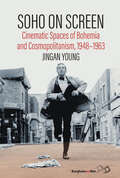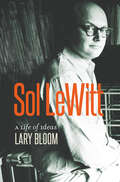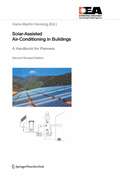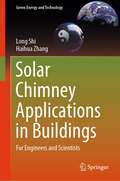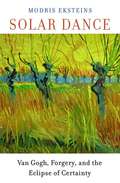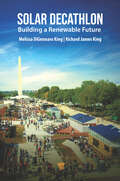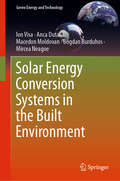- Table View
- List View
Soho on Screen: Cinematic Spaces of Bohemia and Cosmopolitanism, 1948-1963
by Jingan YoungDespite Soho’s rich cultural history, there remains an absence of work on the depiction of the popular neighbourhood in film. Soho on Screen provides one of the first studies of Soho within postwar British cinema. Drawing upon historical, cultural and urban studies of the area, this book explores twelve films and theatrically released documentaries from a filmography of over one hundred Soho set productions. While predominantly focusing on low-budget, exploitation films which are exemplars of British and international filmmaking, Young also offers new readings of star and director biographies, from Laurence Harvey to Emeric Pressburger, and in so doing enlivens discussion on filmmaking in a time and place of intense social transformation, technological innovation and growing permissiveness.
Soho on Screen: Cinematic Spaces of Bohemia and Cosmopolitanism, 1948-1963
by Jingan YoungDespite Soho’s rich cultural history, there remains an absence of work on the depiction of the popular neighbourhood in film. Soho on Screen provides one of the first studies of Soho within postwar British cinema. Drawing upon historical, cultural and urban studies of the area, this book explores twelve films and theatrically released documentaries from a filmography of over one hundred Soho set productions. While predominantly focusing on low-budget, exploitation films which are exemplars of British and international filmmaking, Young also offers new readings of star and director biographies, from Laurence Harvey to Emeric Pressburger, and in so doing enlivens discussion on filmmaking in a time and place of intense social transformation, technological innovation and growing permissiveness.
The Soiling and Cleaning of Building Facades
by L.G.W. VerhoefThe report of a comprehensive investigation by RILEM which examines all aspects of the cleaning of facades, subject to soiling by both biological and non-biological agencies. The contributors are international authorities working in this field giving essential advice to all those who need to know how to approach the problems connected with the soiling and cleaning of building facades.
The Soiling and Cleaning of Building Facades
by L. G. W. VerhoefThe report of a comprehensive investigation by RILEM which examines all aspects of the cleaning of facades, subject to soiling by both biological and non-biological agencies. The contributors are international authorities working in this field giving essential advice to all those who need to know how to approach the problems connected with the soiling and cleaning of building facades.
Soils and Foundations for Architects and Engineers
by Chester I. DuncanSoils and Foundations for Architects and Engineers, Second Edition is a practical guide to the technology of soil mechanics and foundations, and the application of that technology to the design and construction process. This text provides an up-to-date overview of the classification of soils, the design of foundations, and the behavior of soils under load. Particular emphasis has been given to the subject of piles, piers, and caissons, and to the design and details of construction of basement and retaining walls. New to this edition: Expanded coverage of shear strength of soils, settlement analysis, and expansive soil. Design requirements for prestressed tiebacks, tiedowns, and rock anchors. Expansion of information on pile driving techniques including the use of the Engineering News Formula. A table of British-metric conversions. Many new solved problems and illustrations. In addition to the numerous new improvements, the author also includes: effects of high water tables on architectural and engineering considerations, design of shear keys used in the transfer of lateral earth pressure from a wall to the supporting element, various drainage alternatives to the structural treatment of adjacent footings, and much more. Soils and Foundations for Architects and Engineers, Second Edition can be used in advanced undergraduate and graduate level courses offered in architectural engineering and civil engineering, as well as be used as a reference book by practicing architects, insurance adjusters and attorneys who litigate or adjudicate claims involving soils and foundations.
Soils and Foundations for Architects and Engineers
by Chester I. DuncanSoils and Foundations for Architects and Engineers provides in-depth, yet simplified, information on the more commonly encountered aspects of soils mechanics and foundations. It also redefines and clarifies many frequently misunderstood aspects of soil mechanics and foundations such as the actual failure mode of footing due to excessive vertical or lateral pressure theory and the effect of groundwater.
Sol LeWitt: A Life of Ideas (The Driftless Connecticut Series & Garnet Books)
by Lary BloomSol LeWitt (1928-2007), one of the most influential artists of the twentieth century, upended traditional practices of how art is made and marketed. A key figure in minimalism and conceptualism, he proclaimed that the work of the mind is much more important than that of the hand. For his site-specific work—wall drawings and sculpture in dozens of countries—he created the idea and basic plan and then hired young artists to install the pieces. Though typically enormous and intricate, the physical works held no value. The worth was in the pieces of paper that certified and described them. LeWitt championed and financially supported colleagues, including women artists brushed aside by the bullies of a male-dominated profession. Yet the man himself has remained an enigma, as he refused to participate in the culture of celebrity. Lary Bloom's book draws on personal recollections of LeWitt, whom he knew in the last years of the artist's life, as well as LeWitt's letters and papers and over one hundred original interviews with his friends and colleagues, including Chuck Close, Ingrid Sischy, Philip Glass, Adrian Piper, Jan Dibbets, and Carl Andre. This absorbing chronicle brings new information to our understanding of this important artist, linking the extraordinary arc of his life to his iconic work. Includes 28 illustrations.
Solar Air Systems: A Design Handbook
by Robert HastingsActive solar systems for air heating are a straightforward yet effective way of using solar energy for space heating and tempering ventilation air. They offer some unique advantages over solar water systems, can offer improved comfort and fuller use of solar gains than passive solar systems and are a natural fit with mechanically ventilated buildings. They can be economical, with short pay-back periods and can act not only as space heating or ventilation air heating but also for water pre-heating, sunshading, electricity generation (with hybrid photovoltaic systems) and can help induce cooling. This design handbook takes architects and building engineers through the process of designing and selecting an active solar system from the six types presented, optimizing the system using nomograms and curves, and finally dimensioning the components of the system. Tips are offered regarding the construction and how to avoid problems. The book will provide essential design information for all architects, building engineers and other building design professionals and all those concerned to reduce the environmental impact of buildings.
Solar Air Systems: A Design Handbook
by Robert HastingsActive solar systems for air heating are a straightforward yet effective way of using solar energy for space heating and tempering ventilation air. They offer some unique advantages over solar water systems, can offer improved comfort and fuller use of solar gains than passive solar systems and are a natural fit with mechanically ventilated buildings. They can be economical, with short pay-back periods and can act not only as space heating or ventilation air heating but also for water pre-heating, sunshading, electricity generation (with hybrid photovoltaic systems) and can help induce cooling. This design handbook takes architects and building engineers through the process of designing and selecting an active solar system from the six types presented, optimizing the system using nomograms and curves, and finally dimensioning the components of the system. Tips are offered regarding the construction and how to avoid problems. The book will provide essential design information for all architects, building engineers and other building design professionals and all those concerned to reduce the environmental impact of buildings.
Solar Air Systems - Built Examples
by Robert HastingsThirty-five different buildings with successfully installed solar air systems are described and documented. The building types cover single family houses, apartment buildings, schools, sports halls, and industrial commercial buildings with six different configurations of solar air systems used. Each example building is described over several pages, with plans, performance details and illustrations provided. This is supplemented by a summary of the types of system used.
Solar Air Systems - Built Examples
by Robert HastingsThirty-five different buildings with successfully installed solar air systems are described and documented. The building types cover single family houses, apartment buildings, schools, sports halls, and industrial commercial buildings with six different configurations of solar air systems used. Each example building is described over several pages, with plans, performance details and illustrations provided. This is supplemented by a summary of the types of system used.
Solar Architecture in Cool Climates
by Colin Porteous'A must-read for practitioners, teachers and others interested in or working with energy use in the built environment, including a delightful set of examples' Ann Grete Hestnes, former President of the International Solar Energy Society Solar Architecture in Cool Climates is an invaluable primer on low energy building design, combining accessible information with convincing arguments enabling new techniques to be implemented in daily practice. Approaching the topic in a thematic manner, the book provides inspiration, an understanding of key principles and technical data on the design of solar buildings in higher latitudes. The text is enlivened through direct experience of case studies from Europe and North America dealing with new-build, retrofitting and conceptual projects that outline future potential (the principles being equally applicable to equivalent southern latitude locations. The authors examine the dilution of additional costs through different strategies, the tensions between energy efficiency and environmental quality, and the proactive control of energy in building design. Promoting flexibility and opportunity to a diverse audience, including those who use, procure and finance buildings, the book aims to bring the design of 'green' solar buildings in cool climates from special interest status into the mainstream. Broader environmental issues relating to solar architecture are addressed in the final chapter, again drawing on case studies from the authors' own wide experience. Solar Architecture in Cool Climates is written for architects and other building designers, students of architecture and other professionals interested in sustainable architecture, renewable energy and engineering.
Solar Architecture in Cool Climates
by Colin Porteous'A must-read for practitioners, teachers and others interested in or working with energy use in the built environment, including a delightful set of examples' Ann Grete Hestnes, former President of the International Solar Energy Society Solar Architecture in Cool Climates is an invaluable primer on low energy building design, combining accessible information with convincing arguments enabling new techniques to be implemented in daily practice. Approaching the topic in a thematic manner, the book provides inspiration, an understanding of key principles and technical data on the design of solar buildings in higher latitudes. The text is enlivened through direct experience of case studies from Europe and North America dealing with new-build, retrofitting and conceptual projects that outline future potential (the principles being equally applicable to equivalent southern latitude locations. The authors examine the dilution of additional costs through different strategies, the tensions between energy efficiency and environmental quality, and the proactive control of energy in building design. Promoting flexibility and opportunity to a diverse audience, including those who use, procure and finance buildings, the book aims to bring the design of 'green' solar buildings in cool climates from special interest status into the mainstream. Broader environmental issues relating to solar architecture are addressed in the final chapter, again drawing on case studies from the authors' own wide experience. Solar Architecture in Cool Climates is written for architects and other building designers, students of architecture and other professionals interested in sustainable architecture, renewable energy and engineering.
Solar-Assisted Air-Conditioning in Buildings: A Handbook for Planners
Air conditioning contributes significantly to the energy consumption of buildings in many countries. A promising possibility for energy reduction is the use of solar thermal energy in solar-assisted air conditioning systems. The main advantage of this technology is that cooling loads and solar gains occur at the same time, at least on a seasonal level. However, until today only a few systems have been installed world-wide and design and operation experiences are fairly poor. The goal of this handbook - meanwhile available in the 2nd edition - is to address this lack and to support the planner in the design of solar assisted air-conditioning systems, which use solar collectors as heat source.
Solar Buildings and Neighborhoods: Design Considerations for High Energy Performance (Green Energy and Technology)
by Caroline Hachem-VermetteThis book presents the main principles for designing buildings and neighborhoods with increased potential to capture and utilize solar energy. It discusses practical issues in the design of the built environment and their impact on energy performance; and a range of design considerations, from building components (e.g. the building envelope) to urban planning issues (e.g. density and street layouts). In addition to design guidelines on how to increase buildings’ potential to capture solar energy, the book provides creative tips to increase the aesthetic value of solar technology integration in buildings. Helping readers plan energy-efficient buildings with innovative building envelope technologies, and to understand the impact of early-stage design considerations on the energy performance of buildings and communities, the book offers a valuable source of information for building professionals, including architects, engineers, and urban planners. It can also serve as a reference guide for academics and students of energy efficiency in buildings and urban planning.
Solar Chimney Applications in Buildings: For Engineers and Scientists (Green Energy and Technology)
by Long Shi Haihua ZhangThis book comprehensively describes the operating principles and theoretical foundations of solar chimneys. It covers current research results, including numerical analysis and mathematical models based on different assumptions. Complying with the application of renewable energy in sustainable buildings, solar chimney has received extensive attention as an indispensable part natural ventilation. This book is a guide to the application of solar chimneys from single zones to multi zones, and it provides a reference source of application for construction practitioners and engineering decision-makers. The design basis and the related basic principles of fluid mechanics and natural ventilation design strategies introduced in this book will also be beneficial to college students.
Solar Dance: Van Gogh, Forgery, And The Eclipse Of Certainty
by Modris EksteinsArt dealer Otto Wacker’s 1932 sensational trial in Berlin for selling fake Van Goghs leads Eksteins to a unique narrative of a collapsing Weimar Germany, the rise of another misfit, Adolf Hitler, and the replacement of nineteenth-century certitude with twentieth-century doubt.
Solar Dance: Van Gogh, Forgery, And The Eclipse Of Certainty
by Modris EksteinsArt dealer Otto Wacker’s 1932 sensational trial in Berlin for selling fake Van Goghs leads Eksteins to a unique narrative of a collapsing Weimar Germany, the rise of another misfit, Adolf Hitler, and the replacement of nineteenth-century certitude with twentieth-century doubt.
Solar Decathlon: Building a Renewable Future
by Melissa DiGennaro King Richard James KingThis book is an inspirational story about how an idea got started, hit the ground running, and took flight. Solar Decathlon (SD) was a response to the need for innovative solutions to address a global problem—climate change. Richard King believed a collegiate competition that encouraged creative ingenuity could help transform traditional ways of designing and building houses. His idea was to motivate students to work together to craft unique sustainable, net-zero energy dwellings. Competing teams would display their prototypes in a single location as an educational showcase to the public. Following the inaugural competition and recurring events in Washington, DC, SD spread to multiple locations around the world. This historical narrative with stunning photos is a comprehensive source of information about the inception, development, and growth of Solar Decathlon.
Solar Decathlon: Building a Renewable Future
by Melissa DiGennaro King Richard James KingThis book is an inspirational story about how an idea got started, hit the ground running, and took flight. Solar Decathlon (SD) was a response to the need for innovative solutions to address a global problem—climate change. Richard King believed a collegiate competition that encouraged creative ingenuity could help transform traditional ways of designing and building houses. His idea was to motivate students to work together to craft unique sustainable, net-zero energy dwellings. Competing teams would display their prototypes in a single location as an educational showcase to the public. Following the inaugural competition and recurring events in Washington, DC, SD spread to multiple locations around the world. This historical narrative with stunning photos is a comprehensive source of information about the inception, development, and growth of Solar Decathlon.
Solar Energy: Technologies and Project Delivery for Buildings (RSMeans)
by Andy WalkerSolar Energy is an authoritative reference on the design of solar energy systems in building projects, with applications, operating principles, and simple tools for the construction, engineering, and design professional. The book simplifies the solar design and engineering process, providing sample documentation and special tools that provide all the information needed for the complete design of a solar energy system for buildings to enable mainstream MEP and design firms, and not just solar energy specialists, to meet the growing demand for solar energy systems in building projects.
Solar Energy: Technologies and Project Delivery for Buildings (RSMeans)
by Andy WalkerSolar Energy is an authoritative reference on the design of solar energy systems in building projects, with applications, operating principles, and simple tools for the construction, engineering, and design professional. The book simplifies the solar design and engineering process, providing sample documentation and special tools that provide all the information needed for the complete design of a solar energy system for buildings to enable mainstream MEP and design firms, and not just solar energy specialists, to meet the growing demand for solar energy systems in building projects.
Solar Energy Conversion in Communities: Proceedings of the Conference for Sustainable Energy (CSE) 2020 (Springer Proceedings in Energy)
by Ion Visa Anca DutaThis book presents novel findings concerning the systems, materials and processes used in solar energy conversion in communities. It begins with the core resource – solar radiation – and discusses the restrictions on the wide-scale implementation of conversion systems imposed by the built environment, as well as potential solutions. The book also describes efficient solar energy conversion in detail, focusing on heat and electricity production in communities and water reuse. Lastly, it analyzes the concept of sustainable communities, presenting examples from around the globe, along with novel approaches to improving their feasibility and affordability. Though chiefly intended for professionals working in the field of sustainability at the community level, the book will also be of interest to researchers, academics and doctoral students.
Solar Energy Conversion Systems in the Built Environment (Green Energy and Technology)
by Ion Visa Anca Duta Macedon Moldovan Bogdan Burduhos Mircea NeagoeThis book focuses on solar energy conversion systems that can be implemented in the built environment, at building or at community level. The quest for developing a sustainable built environment asks for specific solutions to provide clean energy based on renewable sources, and solar energy is considered one of the cleanest available energy on Earth. The specific issues raised by the implementation location are discussed, including the climatic profile distorted by the buildings, the available surface on the buildings for implementation, etc. This book also discusses the seasonal and diurnal variability of the solar energy resource in parallel with the variability of the electrical and thermal energy demand in the built environment (particularly focusing on the residential buildings). Solutions are proposed to match these variabilities, including the development of energy mixes with other renewables (e.g. geothermal or biomass, for thermal energy production). Specific solutions, including case studies of systems implemented on buildings all over the world, are presented and analyzed for electrical and for thermal energy production and the main differences in the systems design are outlined. The conversion efficiency (thus the output) and the main causes of energy losses are considered in both cases. The architectural constraints are additionally considered and novel solar energy convertors with different shapes and colors are presented and discussed. The durability of the solar energy conversion systems is analyzed considering the specific issues that occur when these systems are implemented in the built environment; based on practical examples, general conclusions are formulated and specific aspects are discussed in relation to experimental results and literature data. With renewables implemented in the built environment likely to expand in the near future, this book represents welcome and timely material for all professionals and researchers that are aiming to provide efficient and feasible solutions for the sustainable built environment.
Solar Energy Houses: Strategies, Technologies, Examples
by Anne-Grete Hestnes Robert Hastings Bjarne SaxhofPassive and active solar strategies together with the adoption of energy conservation measures and the integration of new materials and technologies can lead to a dramatic reduction of 75-90 per cent in the energy consumption of the buildings. The objective of Task 13 of the IEA's Solar Heating and Cooling Programme was to advance solar building technologies and demonstrate this potential by designing and constructing buildings that met very low energy consumption targets while maintaining a good indoor climate. This revised second edition of this book presents the findings of the Task 13 experts and includes the results of the monitoring programme, conducted to determine the effectives of the techniques and strategies adopted. This new edition also provides a detailed explanation of this research programme in terms of how far the expectations of the Task experts were met and highlights the specific successes and lessons learned from the project.
